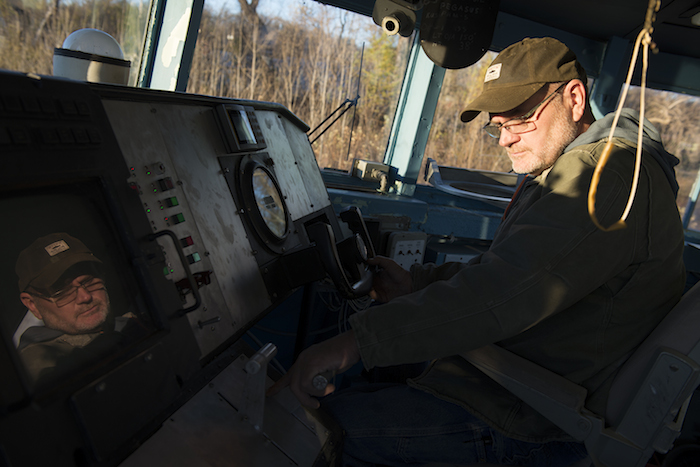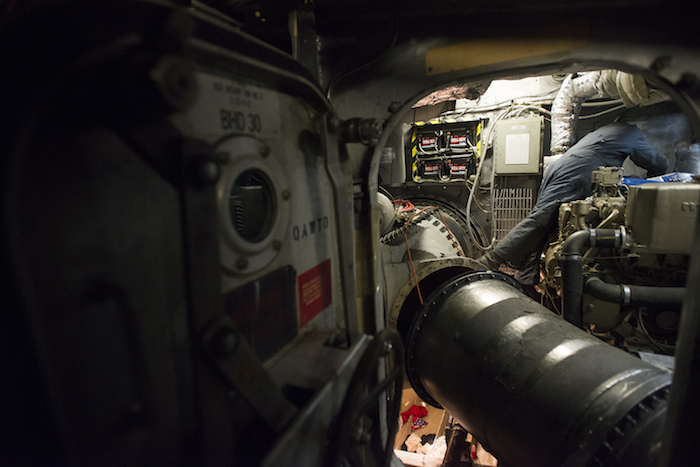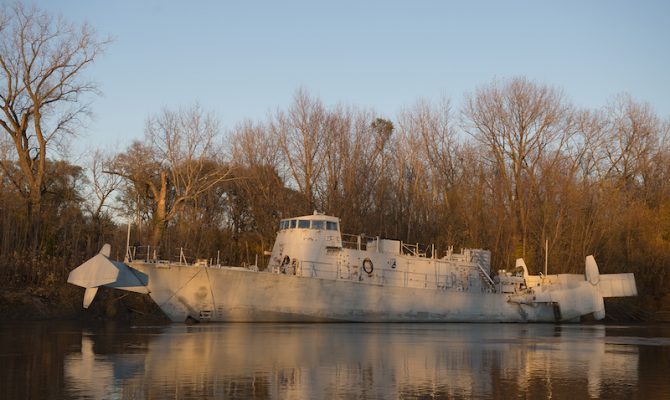Below deck in the mess room, the dining menu remains pinned to the bulletin board: minestrone soup, hamburgers and oatmeal cookies for lunch every other Wednesday; roast turkey, giblet gravy and apple pie for dinner on alternate Sundays.
There’s a cabinet labeled “spices” and a stand mixer bolted to the stainless-steel counter, in case the ship accelerated from zero to 70 miles per hour to intercept a vessel.
One of six Pegasus-class hydrofoils, the most advanced class of hydrofoil to serve in the U.S. Navy, the USS Aries was equipped with underwater wings, or foils, that could support the hull above the water while cruising.
The Aries was able to sustain foil-borne speeds for extended periods, skimming over waves up to 10 feet tall and making smooth banked turns in choppy waters. Those who have served on the vessel described it like flying.
The Navy decommissioned its hydrofoil program in 1993, stripped the parts and auctioned the ships for salvage. The Aries escaped the scrap yard when three Missouri businessmen, Eliot James and brothers B.J. and Bob Meinhardt, bought the ship sight unseen.
They sailed the Aries to the Grand River at Brunswick, a tributary of the Missouri River, where they have been working for the past 18 years to repair the last Pegasus-class hydrofoil in the world. The Aries recently sailed to a ship yard on the Gasconade River, where its owners hope to fully restore the vessel as a mobile museum that tours from port to port.

Eliot James at the helm of the Aries. Photo by Justin L. Stewart
A Narrow Escape
They never set out to own a hydrofoil, James likes to say, much less an unusual one.
The three men met in the early 1990s when the Meinhardts sold James some property. They bonded over their mutual interests in business, boats and collecting “odd things,” Bob Meinhardt said.
“We all got some Huckleberry Finn and Tom Sawyer in us,” his brother, B.J. Meinhardt, said. “We always wanted to own a boat.”
In 1996, they heard about six aluminum Navy ships up for auction. Ships built in the late ’70s and early ’80s were relatively free of contaminants such as PVC and asbestos, making them the perfect candidates for ship-breaking, James said.
“We thought it might be a good opportunity to turn a profit,” he said.
By his estimates, they could get $150,000 to $200,000 for 150 tons of recyclable scrap aluminum.
“We bought her cheap enough to scrap it if we had to,” B.J. Meinhardt said. “But we never had any intention of scrapping her.”
With their sealed bid of $37,777 — about 5 cents for every pound of salvageable aluminum — they became the owners not of the Aries, but its sister, the USS Hercules.
When James and B.J. Meinhardt flew to the Norfolk, Virginia, shipyard to inspect their purchase, they were surprised to find the Hercules in better shape than they had imagined.
“It’s something we could probably get running again,” James said he remembered thinking.
Around the same time, James said, they received an excited phone call from a manager in the Navy’s defunct Pegasus-class hydrofoil program.
“Do you know what you’ve bought?” James remembered him saying.
After he introduced them to the unique capabilities and history of the Pegasus-class hydrofoils, James said, they were sold.
For another $20,000, they traded the Hercules for the Aries, the last of the Pegasus-class ships that hadn’t been stripped of its hydrofoils.
With advice from online hydrofoil enthusiasts, James and the Meinhardts spent four months in Charleston, South Carolina, refitting the Aries’ motors, transmission and steering for the 2,500 mile trip around Florida and up the Tennessee, Ohio, Mississippi, Missouri and Grand rivers.
“Eliot even built throttle controls for operating the engines. They’re still on there,” B.J. Meinhardt said. “I don’t say we would have passed any maritime inspections, but we came home with really little problems at all.”
“Got some great pictures of our ship under the St. Louis Arch,” James wrote afterward on the International Hydrofoil Society message boards dated October 30, 1997. “There was an opening on the waterfront, and we just pulled in like we owned the joint.”
After their long voyage home, they anchored the Aries on the Grand River just upstream from the public boat ramp at Brunswick, asked a friend in town to keep an eye on the 133-foot ship and returned to their jobs.
“By the time we got home, we were dreadfully broke,” B.J. Meinhardt said. “No money, no income, no nothing.”
James operated a business in Salisbury that made parts for trucks, ships and airplanes, and the Meinhardts dealt in military surplus. In their spare time, they worked on the Aries: upgrading the electrical system, setting up generators and replacing damaged parts.
They also began to collect hydrofoils.
The Aries was the first of nine hydrofoils purchased by them, either jointly or individually.
Standouts include the Fresh-1, an experimental Navy hydrofoil from the 1960s, and the Volga-70 hydrofoil that USSR General Secretary Leonid Brezhnev presented to President Richard Nixon in 1972. They bought the Nixon boat online from the state of Nebraska, James said.
In terms of how much of their money they’ve spent on their hobby, B.J. Meinhardt said, it would be “lots and lots and lots. I don’t think I could begin to imagine how much. If we had a little money, people would call us eccentric, but since we don’t have money, people just call us crazy.”

Bob Meinhardt works in the engine room of the Aries. Photo by Justin L. Stewart
From the Grand to the Gasconade
The decision to anchor the Aries in Grand River created ongoing challenges.
The gangway wasn’t long enough to reach the bank, and a motorboat was needed to climb aboard.
And then there was the ice, which required the use of aerators in the stern to keep water from freezing and damaging the ship.
“The Grand River was not polite to us,” Bob Meinhardt said. “Every time it rained, it would rain trash down or pull our anchors.”
The owners acquired a boat yard at confluence of the Gasconade and Missouri rivers to continue with repairs. The move would also make the Aries more accessible to future visitors, they reasoned.
“We’d rather be ported in Key West or Florida or Louisiana,” B.J. Meinhardt said. “But Gasconade was available, cheap, so that’s where we ended up.”
They left Brunswick on November 7, 2015, but transmission and engine troubles cut short their first voyage downriver since the Aries arrived in Missouri. Three miles into the trip, they turned back for Brunswick.
They checked the transmission filter and the engine, installed pressure gauges, and exactly two weeks later set out again for a successful run to Gasconade.
“We each took turns being the pilot,” B.J. Meinhardt said. “After three or four hours, you’re ready to walk around a little bit. The pilot is pretty much stuck in front of the wheel.”
James and the Meinhardts want to display their other hydrofoils in the shipyard on the Gasconade, with the USS Aries as a traveling centerpiece. “The plan is to travel to Key West in the winter, show on the way down, show on the way back,” B.J. Meinhardt said.
The Aries received non-profit museum status in 2002. As a 501(c)(3) nonprofit organization, the owners can receive tax-exempt donations from individuals, surplus sellers and the Navy.
The owners hope the museum’s non-profit status will facilitate the loan of a special Navy gas turbine needed for the Aries to operate as a true hydrofoil, with its hull above the water.
“Hopefully, if we can get the museum going, we can get something that survives,” B.J. Meinhardt said.
“I’d like to see this ship flying. Everybody I talked to that’s been on them say that it’s like flying.”
This story was originally published in the Columbia Missourian.
The Corvette of the Seas
In the early 1970s, the US Navy, in a joint NATO venture with Italy and Germany, invested in armed patrol boats with hydrofoil technology that could reach high speeds, yet maintain a stable platform from which to shoot.
The Pegasus-class patrol hydrofoil missiles were designed by Boeing Marine Systems to operate through 8- to 13-foot swells at speeds upward of 40 knots.
After the lead ship, the USS Pegasus, was launched in 1974, the Navy ordered five more ships to follow.
Mark Bebar, president of the International Hydrofoil Society, worked as a Naval architect on the Navy’s Pegasus-class hydrofoil program. By his estimates, each hydrofoil cost between $60 million to $70 million to build. And that was before inflation, he said.
Construction began on the USS Aries Janunary 7, 1980, in a Boeing shipyard on the Puget Sound.
Similar to how airplane wings work, Bebar said, Pegasus-class hydrofoils rely on underwater foils attached to the bow and stern of the hull to generate lift. Because the hydrofoil needs to gain enough lift to overcome drag, he said, it had to be lightweight to raise its hull out of the water. Made mostly of aluminum, the 288-gross-ton Aries could carry up to 15 percent of its total weight in military gear.
At low speeds, two diesel engines powered the hydrofoil through the water. For foil-borne flight, the crew switched to its LM-2500 engine, a special gas turbine made by General Electric. Once the hydrofoil reached 25 to 26 knots, Bebar said, the ship’s hull comes out of the water.
With only its foils in the water, the hull is “decoupled” from the waves, he said. As a result, there’s less rocking and rolling and pitching.
“You get a very, very smooth ride,” Bebar said. “You could stand a glass of water over the dashboard, and the water would hardly be disturbed.”
Lt. Ken Blalock, combat systems officer on the Aries, served on the vessel between 1992 and 1993, remembered it like this:
“The rest of the Navy had semi-trucks and we had the Corvette.”
On September 18, 1982, the Navy commissioned the Aries and assigned it to a home port in Key West, Florida, where it performed training exercises and assisted the Coast Guard in thwarting drug smugglers.
“They busted over a billion dollars worth in street drugs,” Bebar said.
Ten years into the Aries’ service, the Navy decommissioned its hydrofoil program in 1993, partly because it began to favor larger ships.
All six hydrofoils sailed in formation up the Chesapeake Bay to the Naval base in Little Creek, Virginia, for decommissioning.
“It was kind of a sad day because all of them had service life left in them,” Bebar, who attended the ceremony, said.




